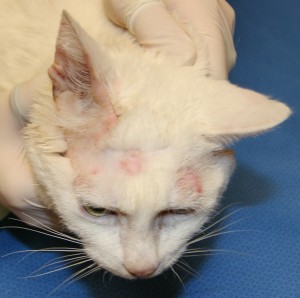Archive ∙ Back to Island Voices
March 2012
A frantic mother calls her veterinarian. She’s just been told by her family doctor that her child’s ringworm came from the family cat. She’s looking at euthanasia.
This may seem like a drastic measure, but in May of 2010, the Newmarket OSPCA was planning to euthanize 350 animals to stem a vigorous outbreak. Shelter outbreaks of ringworm are problems. The disease is highly contagious between animals and it is a zoonosis—it can spread to people.
Ringworm is not a worm. It is a fungal infection that invades hair shafts, causing them to weaken and break off. The fungus also grows in the superficial skin layers forming a characteristic ring as it spreads outward.
Ringworm is usually a disease of kittens and puppies. The fungus takes hold because the immunity of young ones is not fully developed. In older animals, we see outbreaks when their immunity is compromised due to stress or disease.
Ringworm starts as a bare spot on the skin, usually on the top of the head or on an ear. The affected skin is a little scaly but otherwise normal. There is no evidence of redness or inflammation. Ringworm is not itchy.
Ringworm can be diagnosed by shining a Wood’s lamp—an ultraviolet light—on the suspicious area. You get a positive diagnosis when the fungal spores glow a luminous green. Unfortunately, only half the cases of ringworm will show up as positive on this test.
Another way to diagnose ringworm is to culture (grow) the fungus to confirm its identity. Because growth can take a few weeks, the disease is often treated before a definitive diagnosis is made.
Most cases of ringworm, given time, will clear up and don’t need treatment. However, because it can spread so easily, it needs treating. Treatment often consists of antifungal medications such as oral griseofulvin or ketoconazole.
Topical treatment can also work. The dog is clipped and then shampooed with a ketoconazole product or dipped in lime sulfur. This also helps lower environmental contamination.
What happened in Newmarket? Just under 100 animals were euthanized before a public outcry halted the massacre. It then turned out that ringworm was never confirmed (no cultures were taken).
For more information contact Dr. Jeff Grognet or Dr. Louise Janes at
Mid-Isle Veterinary Hospital
5-161 Fern Road West
Qualicum Beach, BC
Tel (250) 752-8969



